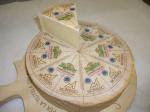 |
| Asiago |
Details: Asiago is available in three stages of aging, fresh (fresco) aged about two months, medium (mezzano) aged for three to five months and (vecchio) which is aged for nine to twelve months. .
Italian Cheese Sampler at Amazon
Tasting and Flavor: Asiago Fresco is neither salty nor bitter and has a slight acidity similar to that of whole yogurt. Asiago Mezzano and Vecchio have decisive and salty complex flavors and are much more aromatic. Pleasantly spicy hints can be perceived in the more mature vecchio version and its rich aroma is reminiscent of butter, yeast, dried fruits, or some say, boiled chestnuts. The fresh version has a light beige rind and interior paste that has many small holes, the aged versions have a dry grayish outer rind and an interior paste dotted with many small holes and a bone white to amber color. Asiago has a fat content between 30% to 45% with the aged version having the higher fat percentage.
Fresh or aged, Asiago cheese is a popular ingredient in the Italian kitchen. It can be enjoyed as a complement to pasta, rice, pizza, sliced on sandwiches or soups. Asiago is a wonderful substitute for grated Parmesan, Pecorino Romano, or aged Gouda in most recipes. Asiago can be served as a table cheese that can be served with hearty bread, salami, or with sweet fruits like fresh figs or pears. The fresh version of Asiago is wonderful shaved or cubed in a crisp salad..
When shopping look for a whole or partially cut wheel that has the Asiago DOP label on it. Avoid any cheeses that have a grayish pallor to the interior paste or that look old or have cracked rinds. It is usually hard to abuse this cheese but it never hurts to ask for a sample to taste to insure that you are getting a good quality cheese.
Wine parings: As a general rule of thumb, the older the Asiago, the stronger your wine. Pair fresh Asiago with similarly young, soft, and delicate flavors. Try white, light rosé, or dry sparkling wines such as Sauvignon Blanc, Pinot Gris, or a Franciacorta Brut Spumante.
Matured Asiago requires a more robust, full-bodied red wine for sipping and savoring. Try a Rioja, Cabernet, Bardolino Barolo or Chianti Reserva.
Both types of Asiago also pair nicely with non-alcoholic beverages such as cranberry and sparkling grape juice.
